Make a circle illusion animation
Python 3.4
Using the turtle module. The turtles are different colours and they always face in the same direction, so they can be easily seen to be moving along straight lines by just focusing on one of them. Despite this the circle illusion is still strong.
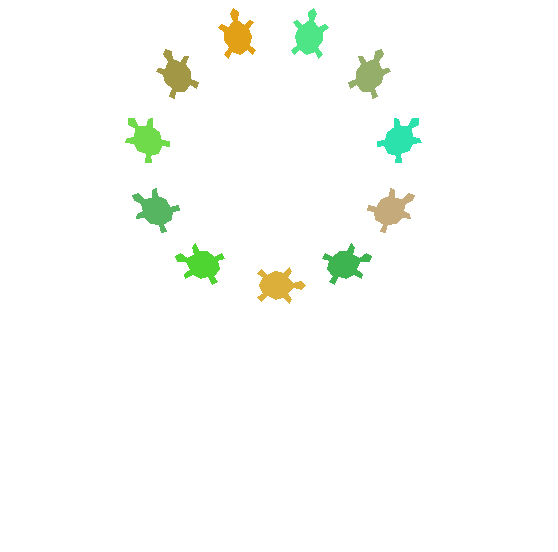
The illusion still seems quite strong even with just 3 or 4 turtles:
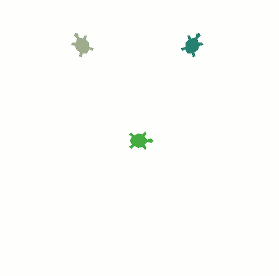
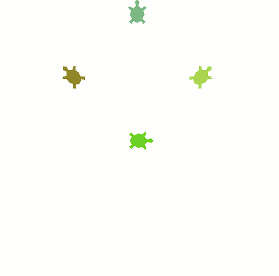
The framerate is reduced considerably for all of these GIF examples, but it doesn't seem to detract from the illusion. Running the code locally gives a smoother animation.
import turtle
import time
from math import sin, pi
from random import random
def circle_dance(population=11, resolution=480, loops=1, flip=0, lines=0):
population = int(population)
resolution = int(resolution)
radius = 250
screen = turtle.Screen()
screen.tracer(0)
if lines:
arrange_lines(population, radius)
turtles = [turtle.Turtle() for i in range(population)]
for i in range(population):
dancer = turtles[i]
make_dancer(dancer, i, population)
animate(turtles, resolution, screen, loops, flip, radius)
def arrange_lines(population, radius):
artist = turtle.Turtle()
for n in range(population):
artist.penup()
artist.setposition(0, 0)
artist.setheading(n / population * 180)
artist.forward(-radius)
artist.pendown()
artist.forward(radius * 2)
artist.hideturtle()
def make_dancer(dancer, i, population):
dancer.setheading(i / population * 180)
dancer.color(random_turtle_colour())
dancer.penup()
dancer.shape('turtle')
dancer.turtlesize(2)
def random_turtle_colour():
return random() * 0.9, 0.5 + random() * 0.5, random() * 0.7
def animate(turtles, resolution, screen, loops, flip, radius):
delay = 4 / resolution # 4 seconds per repetition
while True:
for step in range(resolution):
timer = time.perf_counter()
phase = step / resolution * 2 * pi
draw_dancers(turtles, phase, screen, loops, flip, radius)
elapsed = time.perf_counter() - timer
adjusted_delay = max(0, delay - elapsed)
time.sleep(adjusted_delay)
def draw_dancers(turtles, phase, screen, loops, flip, radius):
population = len(turtles)
for i in range(population):
individual_phase = (phase + i / population * loops * pi) % (2*pi)
dancer = turtles[i]
if flip:
if pi / 2 < individual_phase <= 3 * pi / 2:
dancer.settiltangle(180)
else:
dancer.settiltangle(0)
distance = radius * sin(individual_phase)
dancer.setposition(0, 0)
dancer.forward(distance)
screen.update()
if __name__ == '__main__':
import sys
circle_dance(*(float(n) for n in sys.argv[1:]))
For contrast here are some that really do rotate:
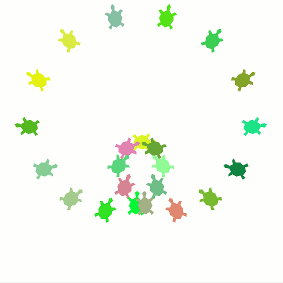
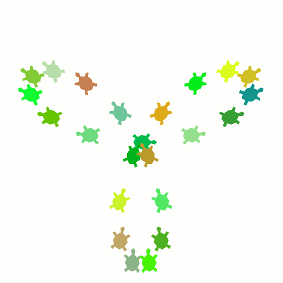
...or do they?
The code can be run with 5 optional arguments: population, resolution, loops, flip and lines.
populationis the number of turtlesresolutionis the time resolution (number of animation frames per repetition)loopsdetermines how many times the turtles loop back on themselves. The default of 1 gives a standard circle, other odd numbers give that number of loops in the string of turtles, while even numbers give a string of turtles disconnected at the ends, but still with the illusion of curved motion.flipif non-zero causes the turtles to flip direction for their return trip (as suggested by aslum so that they are never moving backwards). As default they keep a fixed direction to avoid the visual distraction at the endpoints.linesif non-zero displays the lines on which the turtles move, for consistency with the example image in the question.
Examples with flip set, with and without lines. I've left my main example above without flip as I prefer not to have the sporadic jump, but the edge of the circle does look smoother with all the turtles aligned, so the option is there for people to choose whichever style they prefer when running the code.

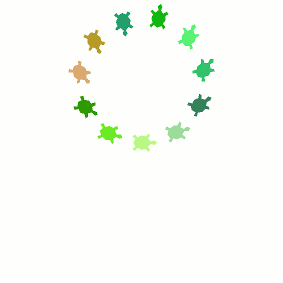
It might not be immediately obvious how the images above were all produced from this same code. In particular the image further up which has a slow outer loop and a fast inner loop (the one that looks like a cardioid that someone accidentally dropped). I've hidden the explanation of this one below in case anyone wants to delay finding out while experimenting/thinking.
The animation with an inner and outer loop of different sizes was created by setting the number of loops to 15 and leaving the number of turtles at 23 (too low to represent 15 loops). Using a large number of turtles would result in 15 clearly defined loops. Using too few turtles results in aliasing (for the same reason as in image processing and rendering). Trying to represent too high a frequency results in a lower frequency being displayed, with distortion.
Trying out different numbers I found some of these distortions more interesting than the more symmetrical originals, so I wanted to include one here...
C
Result:

#include <stdio.h>
#include <Windows.h>
#include <Math.h>
int round (double r) { return (r > 0.0) ? (r + 0.5) : (r - 0.5); }
void print (int x, int y, char c) {
COORD p = { x, y };
SetConsoleCursorPosition(GetStdHandle(STD_OUTPUT_HANDLE), p);
printf("%c", c);
}
int main ()
{
float pi = 3.14159265358979323846;
float circle = pi * 2;
int len = 12;
int hlen = len / 2;
int cx = 13;
int cy = 8;
float w = 11.0;
float h = 8.0;
float step = 0.0;
while (1)
{
system("cls"); // xD
for (int i = 0; i < len; i++)
{
float a = (i / (float)len) * circle;
int x = cx + round(cos(a) * w);
int y = cy + round(sin(a) * h);
print(x, y, 'O');
if (i < hlen) continue;
step -= 0.05;
float range = cos(a + step);
x = cx + round(cos(a) * (w - 1) * range);
y = cy + round(sin(a) * (h - 1) * range);
print(x, y, 'O');
}
Sleep(100);
}
return 0;
}
SVG (no Javascript)
JSFiddle link here
<?xml version="1.0"?>
<svg xmlns="http://www.w3.org/2000/svg" xmlns:xlink="http://www.w3.org/1999/xlink" viewBox="0 0 380 380" width="380" height="380" version="1.0">
<g transform="translate(190 190)">
<circle cx="0" cy="0" r="190" fill="#000"/>
<line x1="0" y1="-190" x2="0" y2="190" stroke="#fff" stroke-width="1.5"/>
<line x1="72.71" y1="175.54" x2="-72.71" y2="-175.54" stroke="#fff" stroke-width="1.5"/>
<line x1="134.35" y1="134.35" x2="-134.35" y2="-134.35" stroke="#fff" stroke-width="1.5"/>
<line x1="175.54" y1="72.71" x2="-175.54" y2="-72.71" stroke="#fff" stroke-width="1.5"/>
<line x1="190" y1="0" x2="-190" y2="0" stroke="#fff" stroke-width="1.5"/>
<line x1="175.54" y1="-72.71" x2="-175.54" y2="72.71" stroke="#fff" stroke-width="1.5"/>
<line x1="134.35" y1="-134.35" x2="-134.35" y2="134.35" stroke="#fff" stroke-width="1.5"/>
<line x1="72.71" y1="-175.54" x2="-72.71" y2="175.54" stroke="#fff" stroke-width="1.5"/>
<g transform="rotate(0)">
<animateTransform attributeType="xml" attributeName="transform" type="rotate" from="0" to="360" begin="0" dur="8s" repeatCount="indefinite"/>
<g transform="translate(0 90)">
<g transform="rotate(0)">
<animateTransform attributeType="xml" attributeName="transform" type="rotate" from="0" to="-360" begin="0" dur="4s" repeatCount="indefinite"/>
<circle cx="0" cy="90" r="10" fill="#fff"/>
<circle cx="63.64" cy="63.64" r="10" fill="#fff"/>
<circle cx="90" cy="0" r="10" fill="#fff"/>
<circle cx="63.64" cy="-63.64" r="10" fill="#fff"/>
<circle cx="0" cy="-90" r="10" fill="#fff"/>
<circle cx="-63.64" cy="-63.64" r="10" fill="#fff"/>
<circle cx="-90" cy="0" r="10" fill="#fff"/>
<circle cx="-63.64" cy="63.64" r="10" fill="#fff"/>
</g>
</g>
</g>
</g>
</svg>